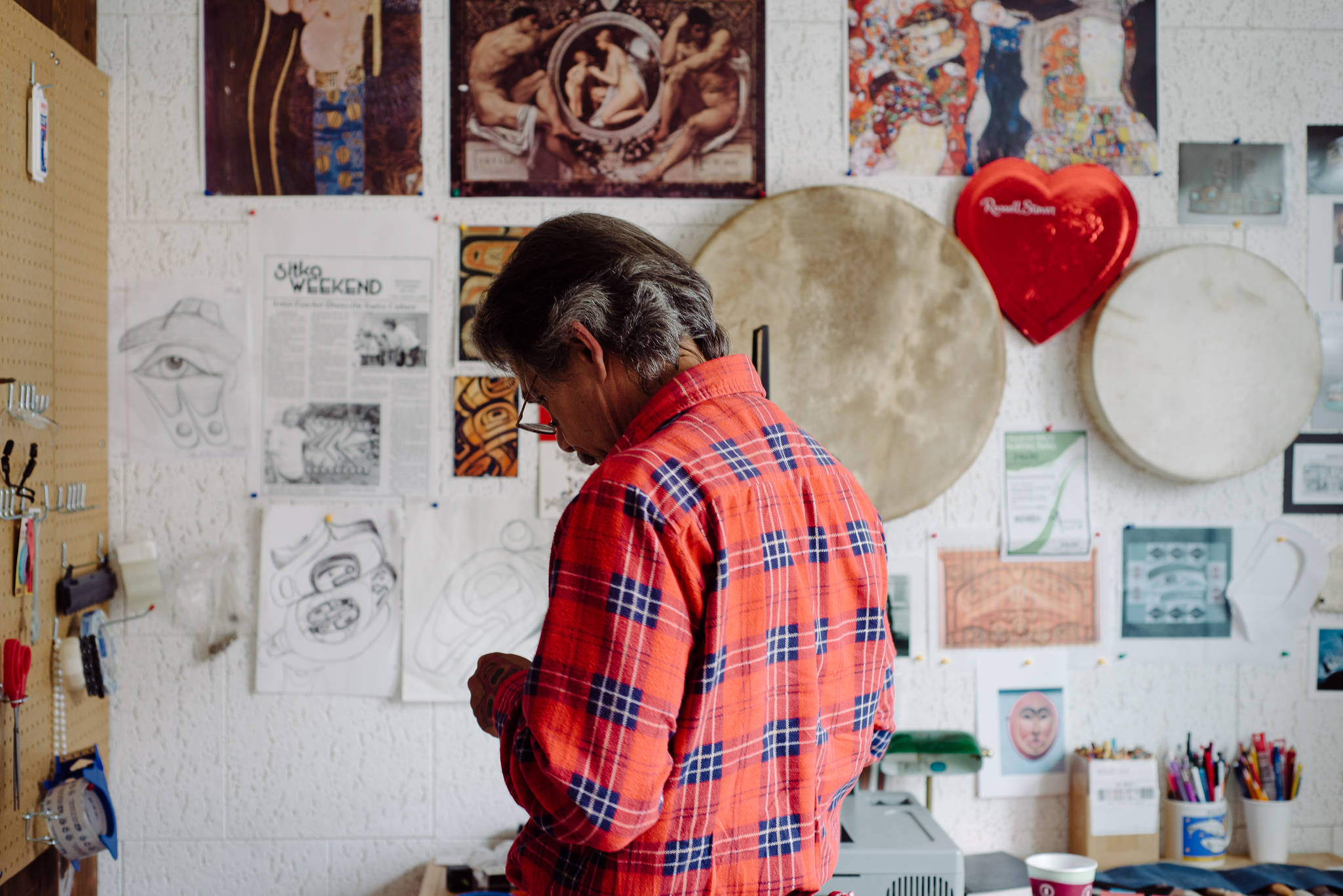Walk halfway down Katlian St. in Sitka, and you’ll find Robert Hoffman’s light-filled, spacious art studio. Shelves filled with colorful paint tubes line the walls, sketches and art prints are tacked to almost every surface, and the air smells of cedar.
In addition to being a practicing painter, carver, and poet, Hoffman also spends his time working at the Sheldon Jackson Museum, which is a joy for him: museums are his favorite place to find inspiration and ideas. In addition to his work as the museum and his art, Hoffman also designs theater sets and teaches workshops, classes, and art camps.
Originally from Kake, Hoffman, who is of Xaay Hít (Yellow Cedar House) of the Tsaagweidi clan, and whose Tlingit name is Xaashuch’eet, has lived for the past 20 years in Sitka. After he finished high school he moved to San Francisco to attend the Academy of Art in San Francisco. Coming straight from Kake, it was a complete culture shock for Hoffman. He soon returned home to Southeast Alaska, but not before taking a sculpture class that helped him overcome an obstacle that was blocking his creative process: guilt around creating any art that strayed from traditional Tlingit art.
Hoffman said his professor was instrumental in helping him understand the difference between tradition and culture, and how he could make experimental art that built on traditional styles without betraying his culture.
“Before I took that class I felt guilty in doing anything besides our traditional art…So I didn’t do too much experimentation. After I went to school in San Francisco it became clear to me that I was not letting myself do some things that were more fulfilling to me: to get very expressive and build on our traditional art form,” Hoffman said. “When we talk about cultural art, it does have a tradition that it’s built on, but the art can evolve as culture evolves.”
While Hoffman’s style is certainly rooted in tradition, he said he finds inspiration in multiple places.
“I love museum collections. I really like looking at some of the old [Tlingit] masterpieces from the late 1800s. I think that was the high-point of the traditional Tlingit art style,” Hoffman said. “And then, there are times when, oddly, I’ll get inspiration from non-Native art. You’ll look around in here and see a lot of [Gustav] Klimt. I’ll get ideas from non-Native art, from unusual sources, and I think I don’t have very much to do with that. …Once an idea enters my mind it feels like my job to pull it off.”
He is always seeking to learn more about art, both Tlingit and non-Tlingit, he said. Hoffman considers his work a way to bridge the past to the present, and chooses to use non-traditional media and techniques as a result.
For Hoffman, painting and carving practices are interconnected. Before he begins a sculpture, he spends time extensively developing his design on paper before beginning the lengthy process of transferring it to wood. He enjoys the quality of wood grain and, in addition to carving with cedar, chooses to paint on birch panels. The smooth quality of the birch lends itself nicely to the hard-edge, formline style Hoffman employs; canvas is too lumpy.
One of Hoffman’s frustrations is that he doesn’t always feel he has the skills necessary to create the ideas that he sees clearly in his mind. He decided to take a beginner’s drawing class recently in an effort to improve his technique. It’s paying off: he recently turned sketching into a daily practice, and it is generating ideas that he is excited by. He looks forward, he said, to creating them on a larger scale – maybe as a carving, or maybe as a painting.
“When I’m writing I think visually,” he said. “And when I’m working on designs, I think both visually and with words. It’s just different forms of expression. It’s pretty much like art. There are different levels of abstraction. Something can mean something very basic or general, or something can be very complicated or hidden.”
This illustrates the value of having more than one medium to express ideas and stories. While writing, painting, and carving are three distinct mediums, Hoffman uses all three to convey his ideas, express his culture, and celebrate the world. Each medium adds another dimension to his creative practice.
His work can be viewed at tlingitart.com.
• Sarah O’Leary is a photographer and writer originally from East Tennessee and currently based in Southeast Alaska. View more of her work at imsaraholeary.com.

